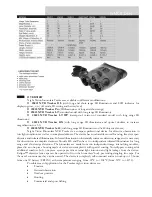
32
Important!
It is advisable to remove the batteries when the device is not used
for more than 24 hours. This prevents the batteries from leaking
and extends their service life.
Please do not use rechargeable batteries, since the base voltage
they provide is insufficient. We recommend using high performance
type AA 1.5 V alkaline batteries.
Use
Remove the lens cap (6).
To switch on the device, turn the wheel (1) until it clicks – whereu-
pon the green indicator will light up. When the batteries are weak,
the indicator will light up red. Line up the device with an object that
is 20-30m away.
Look through the lens (2) and turn it until the black frame of the
screen is clearly visible. Adjust the sensitivity of the device (sen-
sitivity here refers to the brightness of the image) by turning the
wheel (1). To switch on the infrared lamp (4), place the switch (7)
in the IR position.
Adjust the focus to ensure a clear image of the object by turning the
lens (3). When adjusting the observation distance, you will achieve
a higher quality image simply by turning the lens (3) and adjusting
the sensitivity. No further turning of the lens is required, your device
is now set-up ready to use. To transfer the image obtained to an
external screen or for video recording purposes, connect the video
recording cable to the video output (8).
Focusing your device
First of all, look through the device and initially ensure the image
in the eyepiece (2) is sharp, and optimally adjusted to suit your
own eyesight (dioptre adjustment). Finally, turn the lens barrel (3),
to focus the image based on the distance from the object being
observed.
Tripod mount
Your night vision device includes two integrated tripod sockets (9)
on the underside. This facilitates the attachment of most commer-
cially available camera tripods.
Special operating characteristics
The device can be used in day or night, but should not be exposed
to any bright light.
If the device has initially been used in cold conditions and is then
brought into a warmer room, allow it to stand in its case for at least
2-3 hours to avoid any condensation forming on the electro-optical
elements.
Never immerse the device in liquids. Do not expose the device to
either rain or strong sunlight. Avoid exposure to severe shock or
heat sources, which may damage the device.
Do not connect any unsuitable installations to the video output (e.g.
headphones). This may cause the device to fail.

































